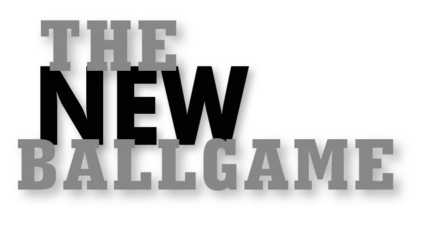The New Ballgame: Understanding Baseball Statistics for the Casual Fan
Read The New Ballgame: Understanding Baseball Statistics for the Casual Fan Online
Authors: Glenn Guzzo




Baseball Statistics
for the Casual Fan
Glenn Guzzo

Why Baseball Arguments Never End/35
Take Me Out to the Ballgame/69
Now Playing on a TV Screen Near You /
99
Appendix: Statistical Resources/
161
To the family who loved baseball first
and nourished my fascination with its numbers:
My mother, Olivia Alanskas, who gave me
my first Strat-O-Matic game;
My father, Alfred Guzzo, who took me
to my first baseball game;
My step-father, Robert Alanskas,
who was always ready to talk baseball;
My uncle, Julius Russu, who in so many ways inspired
my imagination of baseball past and present.
Baseball is "The National Pastime," and one of the reasons is that there are
many different ways to enjoy the game.
Some people are captivated by the pure physical beauty of ballparkswhether in the major or minor leagues, on a college or high school campus, or
just at a local park or playground. For example, the first time people see the
ivy-covered walls of Wrigley Field-at age three or eighty-three-they are
transported to a magical place indeed.
For others, the enjoyment of baseball is in watching one of the greatest games ever invented. The batter-pitcher confrontation is true sport and a
competition that happens 50-100 times every game. There is nothing better
than the drama of a close play at the plate, the grace of a fielder diving and
catching a ball, or the excitement of a runner taking off to steal second base.
And there are always the hot dogs and beer. Nothing tastes better than
a true Wisconsin brat and a "genuine" beer at Miller Park in Milwaukee. As
Humphrey Bogart said in one of his movies, it beats a steak at the Ritz.
For many of us, it's the numbers of the game that provide our greatest
enjoyment. Whether it is just keeping our own scorecard or understanding the
nuances of on-base percentage or earned run average, we enjoy baseball because it lends itself to statistical analysis perhaps better than any other human
endeavor-or at least any other human endeavor that is so much fun!

I have very few memories of my childhood before the age of ten, but
my first baseball game stands out, although I don't remember the exact date. My dad took me to a bat-day doubleheader on the South Side of Chicago. We
only lived a few miles from Comiskey Park, where the Chicago White Sox
played, and the bat-day doubleheader became an annual tradition for my dad
and me. It also became my main source for baseball equipment. Each year's
bat was the bat that I used to play "fast-pitching," the version of baseball we
played on the South Side. It could be played with as few as two players. A
strike-zone box was chalked onto a wall, the pitcher's mound was measured
out at a guesstimated distance that seemed fair, and you threw a rubber ball as
hard as you could for as long as you could to strike each other out.
For some reason, however, I was drawn to the numbers of baseball
from the very first game I ever attended. The best thing I got at the ballpark
was the White Sox yearbook. It cost fifty cents back then. I got one every
year and sat down and studied the numbers in the book as if it were the Bible:
Floyd Robinson was the only Sox player who could hit .300; the ERAs posted
by Gary Peters, Joel Horlen, Juan Pizarro and Hoyt Wilhelm were all very,
very good (all below 2.50, and usually below 2.00); the all-time single season
leader for the White Sox (a tie between Gus Zernial and Ed Robinson) only
had 29 home runs. The statistics went on and on. There was no end to them,
and every one of them was fascinating to me.
When I was about thirteen years old, I found an ad in The Sporting
News for a game called Strat-O-Matic Baseball. I walked to the grocery store,
bought my money order (remember those?), and sent in my five dollars for
the game. A couple of weeks later, after what seemed like an eternity of waiting, the package arrived at my front door. I immediately went over to the
schoolyard where my friends were playing a pick-up game of basketball and
announced that the game had arrived. The basketball game stopped immedi ately. We ran to my house and played Strat-O-Matic on my front porch the
rest of the summer. I can still see Steve Malkowski running down the street
every morning to my house to play the game. I was "Bowie" Dewan that summer, named after Bowie Kuhn, then commissioner of baseball. I was the commissioner of our league, but more importantly, I was the league statistician.
I enjoyed nothing more. I recorded every game I played on scoresheets.
When my friends were playing, I recorded their games too. They all had immediate access to their statistics and loved to boast how well Tony Oliva was
hitting, or how awesome Bob Gibson was pitching. But our Strat-O-Matic
league wasn't enough for me. I began to record stats on my favorite team,
the White Sox. I kept day-by-day logs for every player. For this, the daily
newspaper was essential. I looked up the boxscores and recorded my logs,
one page per player. It got to the point where I spent so much time with my
numbers that my mom threatened to take them away. If there was a chore to
do and I didn't do it, my stat books were in jeopardy. I even took to hiding
them. My favorite place was at the bottom of the laundry hamper, hiding
underneath all the clothes waiting to be washed. I'm not sure why I thought
my mom would never find them there, since she was the one who washed the
clothes! Anyway, once the immediate threat had passed, I'm sure I retrieved
my stats before she had a chance to finish the wash.
My love of baseball numbers led directly to my career after graduating
from school. I became an actuary, a profession that studies the numbers of insurance. I enjoyed it immensely and was benefiting from a good career. Then
I read a book titled The Bill James Baseball Abstract in 1982. Bill James was
an average guy like me, who loved both baseball and statistics, and he almost
single-handedly began the revolution in baseball statistical analysis. Here is my reaction to James' book (as I wrote about in the book How Bill James
Changed Our View of Baseball):